Not to be confused with the blog of the same name, this post deals with my thoughts on lightweight and ultralight backpacking, my experience from going from a normal 20 kg baseweight to a sub 5 kg base weight and what my experiences where along the way.
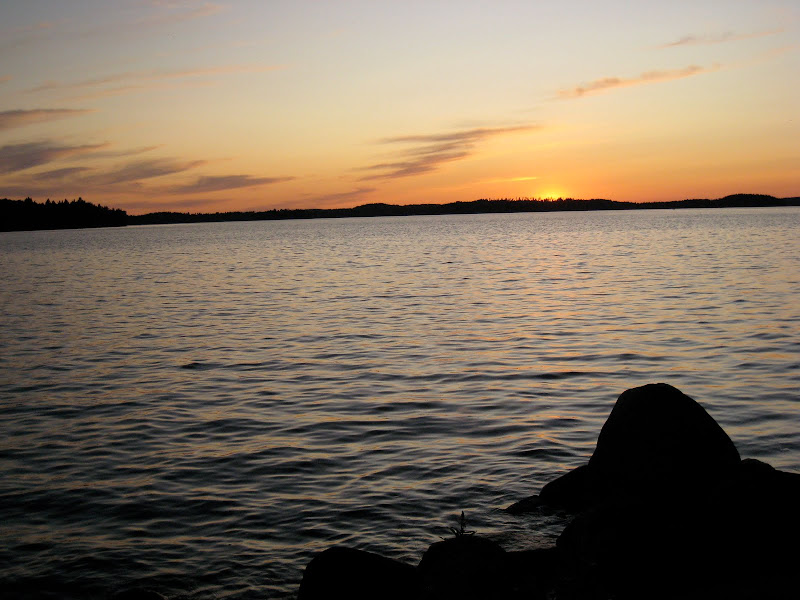
After reading the various blogs, articles and forums you decided to make the step towards a lighter load. But what is important in the beginning? In this completely subjective article I will detail my journey from hauling 20+ kg through the outdoors to going an ultralight load of less than 5 kg. So, I think to see where I started, here's me on a trip in with a heavy load:

As you can see, a massive 80l backpack, a nice heavy fleece pullover and I also had a Fjällräven synthetic jacket with me. On my feet were the dreaded German Army Boots - 1000 g per boot! - and as I didn't know it better back then, long cotton underwear. A down sleeping bag which could have kept me warm till -35°C and a TAR ProLite were my bedding, way overkill for the -10°C I was expecting. From the trip I took a few things home: one Euro coin size blisters on my heels which took well over four weeks to heal, and the realization that if I had gone lighter and better prepared I would have had a better time outside, would have seen more of the flora and fauna, and could have gone further.
One thing I realized already before I bought any UL gear, and that is while the gear will make it easier, it is the mindset that lets one succeed. You need to be open to new things, willing to try new techniques, willing to leave "necessary" items behind. It is a way of mind over matter, skills over gear, that make an ultralight backpacker. Sure one can spend hundreds of euros on 150 gram cuben tarps, 900+ down quilts and the lightest eVent garments there are, and while these certainly help, if you don't know how to use a tarp correctly you might as well have taken nothing or the bombproof equivalent.
Ultralight backpacking is a mindset, a way of life, an attitude, a philosophy. It can be scary for the novice to head to the forests and mountains with ultralight gear, thus some practice in a save environment is advised - there is a reason why I test cookers, pitch tarps & tents and try different rucksacks in the nature reserve behind my house before I head into the distance forest. It is about knowing the gear, being able to use it correctly and feeling comfortable with it, knowing that I will be able to use it also when conditions aren't 30°C and sunshine. If you know your gear and how to use it, also a thunderstorm in the fjell is nothing you need to be worried about.
Once you're on the trail with your tested UL gear, and have left behind the worries that it might not be bombproof enough, you slowly realize that with less weight you're enjoying yourself more. You're feet are less tired and move more natural in your trailrunners, your merino shirt doesn't smell even after three consecutive days of hiking, and the vest is all you need for being warm at camp and breaks.

My old kitchen on the left, the current setup on the right.
So lets have a look at a few items and my thoughts on them. I start with my kitchen, and the photo above shows quite well the evolution (I'm working on an even lighter kitchen, so stay tuned!). Anyhow, from a Trangia I went to a Bushbuddy Ultra and a Titanium pot, and I think it makes a lot of sense to start saving the weight here - it is easy, fun and you need to cook on the trail. The savings in weight are very good, but I like even more the savings in space - the BBU combo is about one third the size of the Trangia & alcohol bottle. I would nowadays make again the exactly same investment of BBU + Titanium pot, but maybe would go for an Evernew pot instead. If your fire skills are decent take the BBU, if you're still practicing take the Bushcooker or Ti-Tri. If your fire skills are so good that you think woodburners are civilized toys, just take a titanium pot and cook over a fire. If gas or alcohol are more convenient for you, take a light setup there, but try to go for the lightest gas stove right away, or build your own 50 g kitchen.
Next, another very not very sexy area to save space and weight - the hygiene area. I wrote about this previously, so won't repeat too much here, but let me point out that a packtowel, a mini dropper bottle with soap and a toothbrush + tooth silk is all you need. No, you don't need a deodorant, no perfume, no 120 x 80 cotton towel, and a huge hand sanitizer bottle for a weekend trip. Most of all, this area is easy and cheap to start! I once again would buy the complete set of items you see there, plus mini dropper bottles to take just what I need for the time I am out.

Progressively lighter: First a Scarp 1.
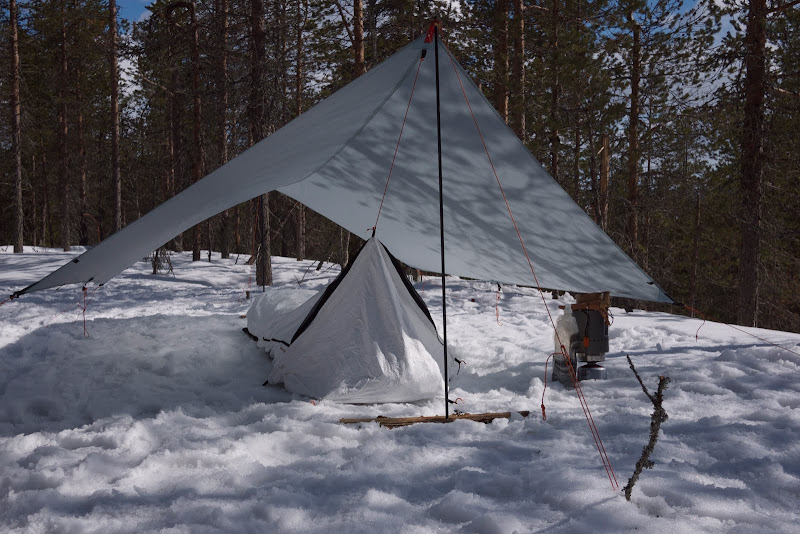
and then quickly a tarp and bivy - also in winter!
Lets look at the hot items. Tarp, quilt & mat, backpack. I started with a Scarp 1, tried a Hubba HP and ended with a SpinnTwinn. To cut a long story short: I'd buy a tarp - or make one - immediately today. I love the freedom, the views, the super lightweight, the ease of use of a tarp. I will try some more tents now and then, but tarps are where my heart is - it allows me to be closer to nature than any tent can. I know it is a big steps to go from the "safety" and enclosedness of a tent to a open space like a tarp, and it surely isn't for everyone and everywhere, but if you want to cut the weight and experience nature, go buy a tarp. Silynlon, spinnaker or cuben, it is a question of money and preferences, but get a tarp.
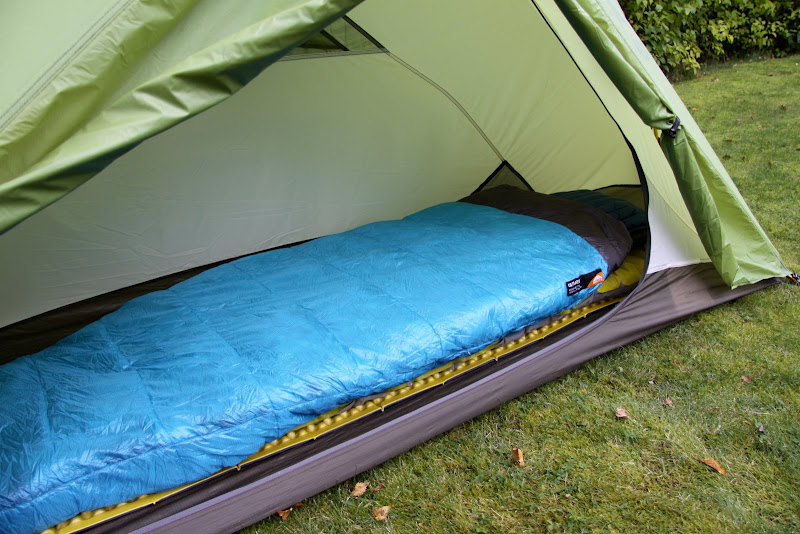
I <3 my quilt.
For sleeping I continue to recommend a quilt for the spring - summer - autumn times, and your mattress or pad of choice. The lighter the better goes for pads in my opinion, though if you need the comfort of a NeoAir or POE Ether Elite, please use it - sleep is important, and those mats can make a difference. For quilts, I like the freedom they offer, and the adaptability. They're also slightly cheaper than comparable sleeping bags, and there are a growing number of cottage manufacturers who make sweet quilts. No surprise, I'd again buy the same quilt and mattresses I have than in the past, though as the GoLite Ultra 20 is no longer easily available, I would look at the products of cottage manufacturers and probably buy something suitable there.
Lastly the backpack, probably the most obvious sign of a UL backpacker. I started with the ULA Ohm, a great pack for beginners for a good price, with great details and craftsmanship. Nowadays I mainly use the LAUFBURSCHE huckePACK, and considering the circumstances I would again buy first the Ohm and then the huckePACK. The Ohm has simply more space, and for someone who is scaling down the weight the bulk is often the biggest hurdle. A slightly bigger pack like the Ohm is thus a good idea, and once you have everything in UL size go for the huckePACK (which, as you surely know, I love!). If the huckePACK would be easily available already now, I would certainly take the 45l size (I have the 35l size pack) and be a happy backpacker with it.
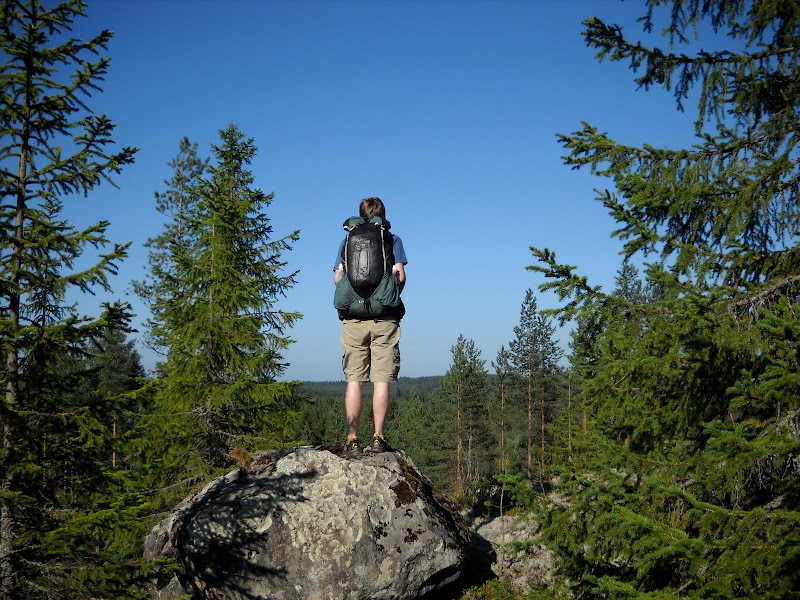
On a trip in the summer of 2009.
There are some more items, like knifes, headlamps, water bottles, clothes, and more. Have a look at my past reviews to see what is good and possibly worth your hard earned money. I'll for completions sake shortly let you know what are my favourite items at the moment: Finisterre merino underwear and Icebreaker merino shirts, Arc'teryx windjacket, Inov-8 trailrunners (and soon VFFs!), super lightweight pants and shirt from BPL, a Finisterre synthetic vest, an umbrella, a good camera and my kuksa!
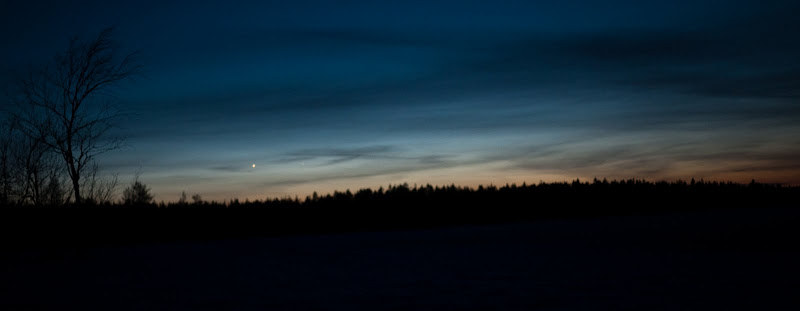
To recap: Invest into books to develop those skills. Go hiking with more experienced UL backpackers and learn from them. Visit courses if you can. Buy right away the best & lightest gear for your usual trips, and check out the cottage manufacturers and the gear they make before you buy from the mainstream companies. Try the new gear in a familiar environment, get familiar with it. But most of all, just go out.

On the Vålådalen trip - photo courtesy of Jörgen Johansson from Fjäderlätt
You now can become a Fan of Hiking in Finland and Nordic Lightpacking on Facebook!

After reading the various blogs, articles and forums you decided to make the step towards a lighter load. But what is important in the beginning? In this completely subjective article I will detail my journey from hauling 20+ kg through the outdoors to going an ultralight load of less than 5 kg. So, I think to see where I started, here's me on a trip in with a heavy load:
As you can see, a massive 80l backpack, a nice heavy fleece pullover and I also had a Fjällräven synthetic jacket with me. On my feet were the dreaded German Army Boots - 1000 g per boot! - and as I didn't know it better back then, long cotton underwear. A down sleeping bag which could have kept me warm till -35°C and a TAR ProLite were my bedding, way overkill for the -10°C I was expecting. From the trip I took a few things home: one Euro coin size blisters on my heels which took well over four weeks to heal, and the realization that if I had gone lighter and better prepared I would have had a better time outside, would have seen more of the flora and fauna, and could have gone further.
One thing I realized already before I bought any UL gear, and that is while the gear will make it easier, it is the mindset that lets one succeed. You need to be open to new things, willing to try new techniques, willing to leave "necessary" items behind. It is a way of mind over matter, skills over gear, that make an ultralight backpacker. Sure one can spend hundreds of euros on 150 gram cuben tarps, 900+ down quilts and the lightest eVent garments there are, and while these certainly help, if you don't know how to use a tarp correctly you might as well have taken nothing or the bombproof equivalent.
Ultralight backpacking is a mindset, a way of life, an attitude, a philosophy. It can be scary for the novice to head to the forests and mountains with ultralight gear, thus some practice in a save environment is advised - there is a reason why I test cookers, pitch tarps & tents and try different rucksacks in the nature reserve behind my house before I head into the distance forest. It is about knowing the gear, being able to use it correctly and feeling comfortable with it, knowing that I will be able to use it also when conditions aren't 30°C and sunshine. If you know your gear and how to use it, also a thunderstorm in the fjell is nothing you need to be worried about.
Once you're on the trail with your tested UL gear, and have left behind the worries that it might not be bombproof enough, you slowly realize that with less weight you're enjoying yourself more. You're feet are less tired and move more natural in your trailrunners, your merino shirt doesn't smell even after three consecutive days of hiking, and the vest is all you need for being warm at camp and breaks.
My old kitchen on the left, the current setup on the right.
So lets have a look at a few items and my thoughts on them. I start with my kitchen, and the photo above shows quite well the evolution (I'm working on an even lighter kitchen, so stay tuned!). Anyhow, from a Trangia I went to a Bushbuddy Ultra and a Titanium pot, and I think it makes a lot of sense to start saving the weight here - it is easy, fun and you need to cook on the trail. The savings in weight are very good, but I like even more the savings in space - the BBU combo is about one third the size of the Trangia & alcohol bottle. I would nowadays make again the exactly same investment of BBU + Titanium pot, but maybe would go for an Evernew pot instead. If your fire skills are decent take the BBU, if you're still practicing take the Bushcooker or Ti-Tri. If your fire skills are so good that you think woodburners are civilized toys, just take a titanium pot and cook over a fire. If gas or alcohol are more convenient for you, take a light setup there, but try to go for the lightest gas stove right away, or build your own 50 g kitchen.
Next, another very not very sexy area to save space and weight - the hygiene area. I wrote about this previously, so won't repeat too much here, but let me point out that a packtowel, a mini dropper bottle with soap and a toothbrush + tooth silk is all you need. No, you don't need a deodorant, no perfume, no 120 x 80 cotton towel, and a huge hand sanitizer bottle for a weekend trip. Most of all, this area is easy and cheap to start! I once again would buy the complete set of items you see there, plus mini dropper bottles to take just what I need for the time I am out.
Progressively lighter: First a Scarp 1.

and then quickly a tarp and bivy - also in winter!
Lets look at the hot items. Tarp, quilt & mat, backpack. I started with a Scarp 1, tried a Hubba HP and ended with a SpinnTwinn. To cut a long story short: I'd buy a tarp - or make one - immediately today. I love the freedom, the views, the super lightweight, the ease of use of a tarp. I will try some more tents now and then, but tarps are where my heart is - it allows me to be closer to nature than any tent can. I know it is a big steps to go from the "safety" and enclosedness of a tent to a open space like a tarp, and it surely isn't for everyone and everywhere, but if you want to cut the weight and experience nature, go buy a tarp. Silynlon, spinnaker or cuben, it is a question of money and preferences, but get a tarp.
I <3 my quilt.
For sleeping I continue to recommend a quilt for the spring - summer - autumn times, and your mattress or pad of choice. The lighter the better goes for pads in my opinion, though if you need the comfort of a NeoAir or POE Ether Elite, please use it - sleep is important, and those mats can make a difference. For quilts, I like the freedom they offer, and the adaptability. They're also slightly cheaper than comparable sleeping bags, and there are a growing number of cottage manufacturers who make sweet quilts. No surprise, I'd again buy the same quilt and mattresses I have than in the past, though as the GoLite Ultra 20 is no longer easily available, I would look at the products of cottage manufacturers and probably buy something suitable there.
Lastly the backpack, probably the most obvious sign of a UL backpacker. I started with the ULA Ohm, a great pack for beginners for a good price, with great details and craftsmanship. Nowadays I mainly use the LAUFBURSCHE huckePACK, and considering the circumstances I would again buy first the Ohm and then the huckePACK. The Ohm has simply more space, and for someone who is scaling down the weight the bulk is often the biggest hurdle. A slightly bigger pack like the Ohm is thus a good idea, and once you have everything in UL size go for the huckePACK (which, as you surely know, I love!). If the huckePACK would be easily available already now, I would certainly take the 45l size (I have the 35l size pack) and be a happy backpacker with it.
On a trip in the summer of 2009.
There are some more items, like knifes, headlamps, water bottles, clothes, and more. Have a look at my past reviews to see what is good and possibly worth your hard earned money. I'll for completions sake shortly let you know what are my favourite items at the moment: Finisterre merino underwear and Icebreaker merino shirts, Arc'teryx windjacket, Inov-8 trailrunners (and soon VFFs!), super lightweight pants and shirt from BPL, a Finisterre synthetic vest, an umbrella, a good camera and my kuksa!

To recap: Invest into books to develop those skills. Go hiking with more experienced UL backpackers and learn from them. Visit courses if you can. Buy right away the best & lightest gear for your usual trips, and check out the cottage manufacturers and the gear they make before you buy from the mainstream companies. Try the new gear in a familiar environment, get familiar with it. But most of all, just go out.

On the Vålådalen trip - photo courtesy of Jörgen Johansson from Fjäderlätt
You now can become a Fan of Hiking in Finland and Nordic Lightpacking on Facebook!
